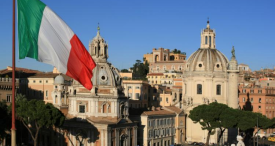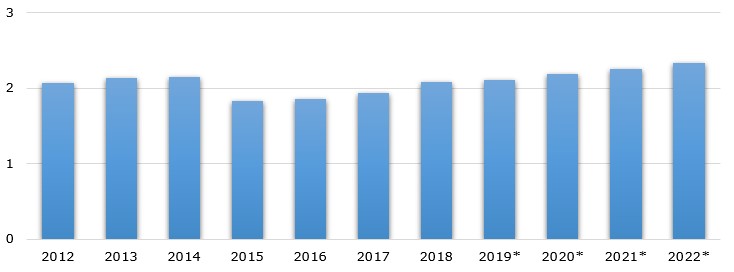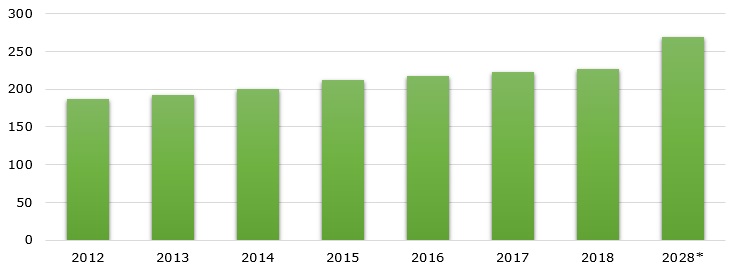Major Industries Driving Economic Growth in Italy
02 Jul 2019 • by Natalie Aster

LONDON – Presently, Italy boasts an advanced economy: the country has the eighth biggest economy by nominal GDP across the globe and the third largest economy in the Eurozone. Moreover, Italy is amid the founding members of such prominent organisations as the European Union, the G7 and the G20, the OECD. Italy enjoys the eighth highest quality of living according to the Human Development Index.
The national economy was considerably affected by the world’s financial recession and got back on the growth trajectory only in 2015. Last year, the Italian GDP increased by 1.2%, down from a 1.6% upturn registered in the year 2017 – this decline in growth rates was attributed to the weakened foreign demand, partially compensated by the mounting domestic demand. The growth rate of Italy’s GDP is poised to further decrease to 1% and 0.9% in the years 2019 and 2020, respectively.
Italy’s GDP during 2012-2022* (in USD trillion), in current prices

MAJOR INDUSTRIAL SECTORS IN ITALY:
- SERVICES SECTOR
The services sector is one of the most prosperous economic sectors in Italy that contributes appr. three-quarters of the country’s GDP. The sector is the top employer in the country: almost 70% of the country’s workforce operates in the services sector.
Tourism is one of the most rapidly-evolving and profitable industries in the Italian service sector. Italy is very popular among travelers – it ranks the fifth most visited country around the globe and the third most visited in the European region. Furthermore, the country possesses the highest number of “World Heritage Sites” around the globe, namely 51. The tourism industry contributes about 11.8% of the Italian GDP and provides appr. 12.8% of the country’s jobs. The surging tourism industry in Italy also gives an impetus to the robust growth of the country’s hotel and accommodation sectors as well as triggers the business of tour companies.
Total contribution of tourism industry to Italy’s GDP (in EUR billion)

Moreover, Italy boasts a well-developed maritime transport industry supported by numerous ports dotted along the country’s coast which is 4,600 miles. The country’s railway lines connect not only its cities but also other countries in the European region. Italy also has a strong expansive road transport system and efficient air transport.
Banking was a flourishing business in medieval Italy and is still plays an essential role in the Italian economy. The country’s UniCredit Bank is amid the top European banks in terms of market capitalization.
Besides, the country is home to the second biggest insurance company (in terms of revenues) around the globe – the Assicurazioni Generali.
The Italian telecommunication sector is also highly-developed with an impressive number of subscribers along with high Internet penetration rates.
- INDUSTRIAL SECTOR
The industrial sector is the second most influential sector of the Italian economy which is responsible for appr. a quarter of national GDP. The sector employs around 30% of the local workforce.
The industrial activity in the country is concentrated in the northern part. There is a smaller number of multinational corporations in the country rather than in other economies of comparable size. The majority of Italian firms are small- and medium-sized businesses (with less than 50 employees), most of them grouped in clusters, – they form the backbone of the Italian industry.
The Northwest region (a.k.a. “Industrial Triangle” – Milan-Turin-Genoa) is home to such large industries as naval, aerospace, machinery, automotive. The Central and Northeast parts of Italy (which were previously rural areas) has many small businesses of high craftsmanship coupled with low technology, specialized in footwear, textiles, clothing, furniture, leather products, jewelry, furniture, etc.
The establishment of the Fiat Company in the year 1899 in Turin spurred the development of the domestic automobile industry. Further, the country’s automobile industry was decentralized by the setting up of other auto plants in such cities as Milan, Naples, and
Brescia. The industry’s stagnation registered in the 1970s started to improve in the 1990s. at present, Italy boasts one of the highest numbers of autos per capita in the world.
Moreover, Italy has the strong iron and steel industry, which has been privatized since the 1990s. Four extensive iron and steel units from the old republic still continue to operate in Genoa, Trieste, Piombino, and Taranto.
Other established businesses in Italy comprise machine tools, appliances, and spare parts, amid others. The country also has a range of food and beverage, and chemicals manufacturing units spread across the country.
Italy’s manufacturing sector often makes emphasis on the export of niche market as well as luxury products, that from one side are less capable of competing on quantity, whilst from the other side are more capable of withstanding the competition from developing economies owing to lower labor costs, however with higher quality.
- AGRICULTURE
Historically, Italy has an agricultural-based economy. However, in the post-war period, the country became one of the world’s most advanced and developed nations, taking the leading position in global trade and exports. Today, the agricultural sector grabs a 1.9% share of the country’s GDP, however, it is heavily dependent on the imports of raw materials used in agricultural production owing to the limited natural resources.
Italy ranks as one of the major agricultural players in the EU: it is the dominant producer of wine (comprising the popular Frascati, Piedmontese Barolo, Tuscan Chianti, and Barbaresco, to name a few), vegetables, fruits (e.g., kiwi, oranges, plums, peaches, apples, apricots, grapes, cherries, lemons, etc.), and rice in Europe. Other main crops cultivated in Italy comprise cereals, barley, corn, and oats. Besides, the country boasts thriving livestock and fishing sectors: the country’s livestock totals to some 6 million heads of cattle, whilst the domestic production of the fishing industry (capture and aquaculture) is about 480 thousand tons.
- TRADE
Italy’s beneficial position along the Mediterranean Sea has enabled the development of a vibrant trading industry in the country especially with Eastern Europe, North Africa, and the Middle East. The participation of the country in the EU further multiplied its trading options.
As of 2016, Italy took eighth place in the world in terms of exports value – it exported appr. USD 514 billion. In 2018, the country shipped around USD 546.9 billion worth of goods across the world – up by 8.7% YoY. Over 2014-2018, the Italian exports improved by 3.2%.
Italy’s total exports of goods during 2007-2018 (in USD billion)

Last year, over 64% of the country’s exports (by value) were delivered to other European countries, whilst appr. 16% were shipped to importers from the Asian region, some 11% – to North America, 3.9% – to Africa, and smaller shares shipped to other regions.
The biggest shares of the country’s exports belong to textiles, engineering products, pharmaceuticals, vehicles, clothing, precious metals, footwear, food and beverage, aircraft, stone, paper, cement, and electrical equipment, amid others. Besides, Italy is one of the leading exporters of luxury goods (e.g., cars, clothing, etc.). Meantime, the country imports such goods as minerals, chemicals, plastics, autos, base metals, etc.
As of 2018, machinery (including computers) grabbed the bulk share (appr. 19.5%) of the total value of goods exported from Italy. The second biggest exports category, accounting for an 8.2% share, was formed by vehicles. The mineral fuels industry registered the fastest growth in terms of exports last year – up by around 25% YoY; this was majorly attributed to the increasing international sales of refined petroleum oils. A remarkable upturn in terms of exports was also registered in such sectors as iron and steel metals (+14% YoY), and electrical machinery and equipment (+12.4% YoY).
Bottom Line
Italy has considerably suffered from disindustrialisation (particularly during the world’s financial crisis), however, it still maintains the position of the second top manufacturing power in Europe and the seventh leading on the global arena.
© MarketPublishers.com, 2019
Analytics & News
